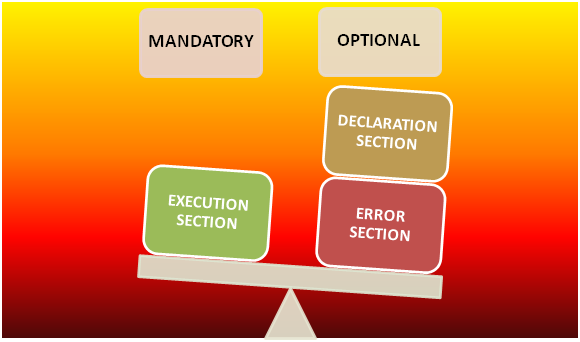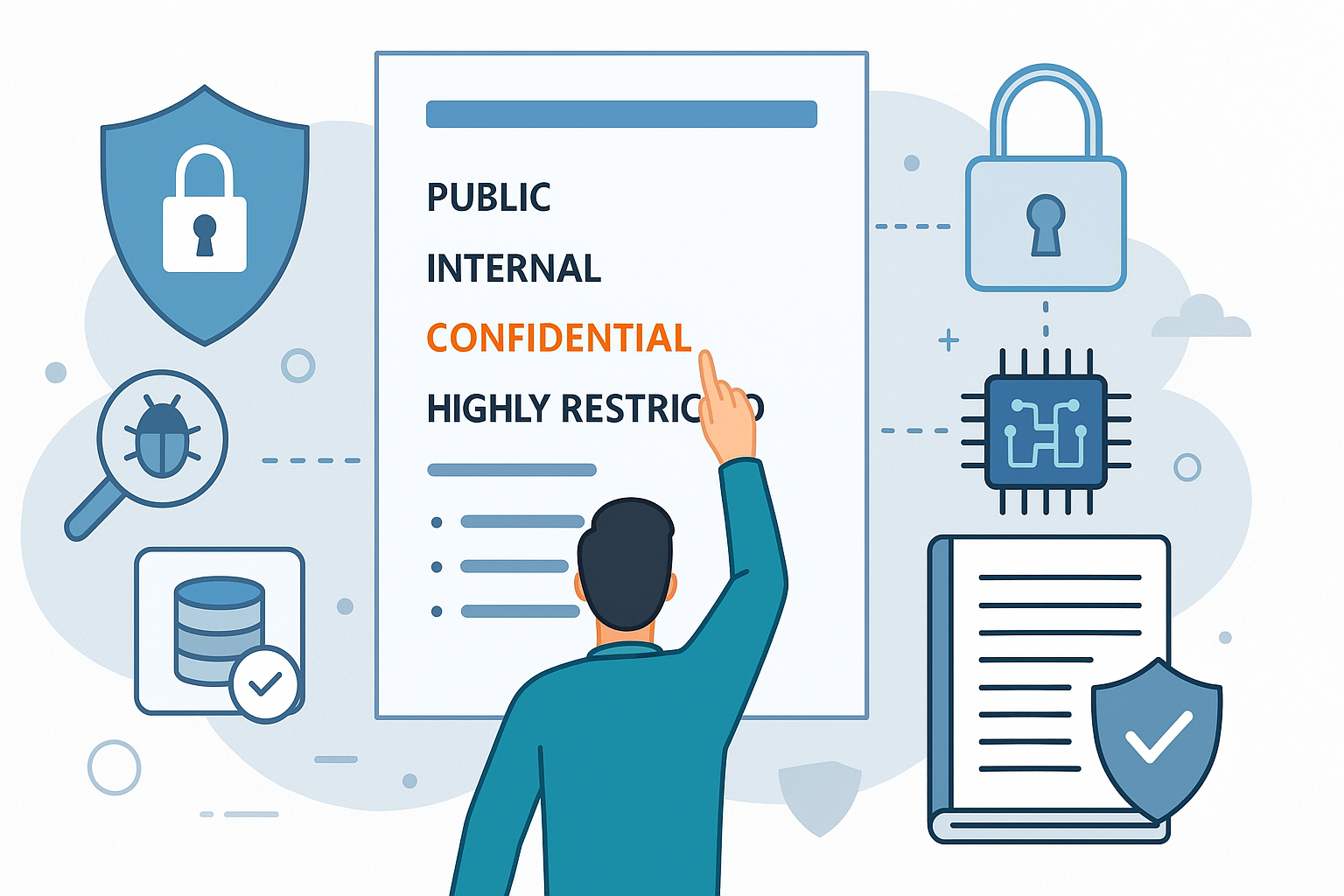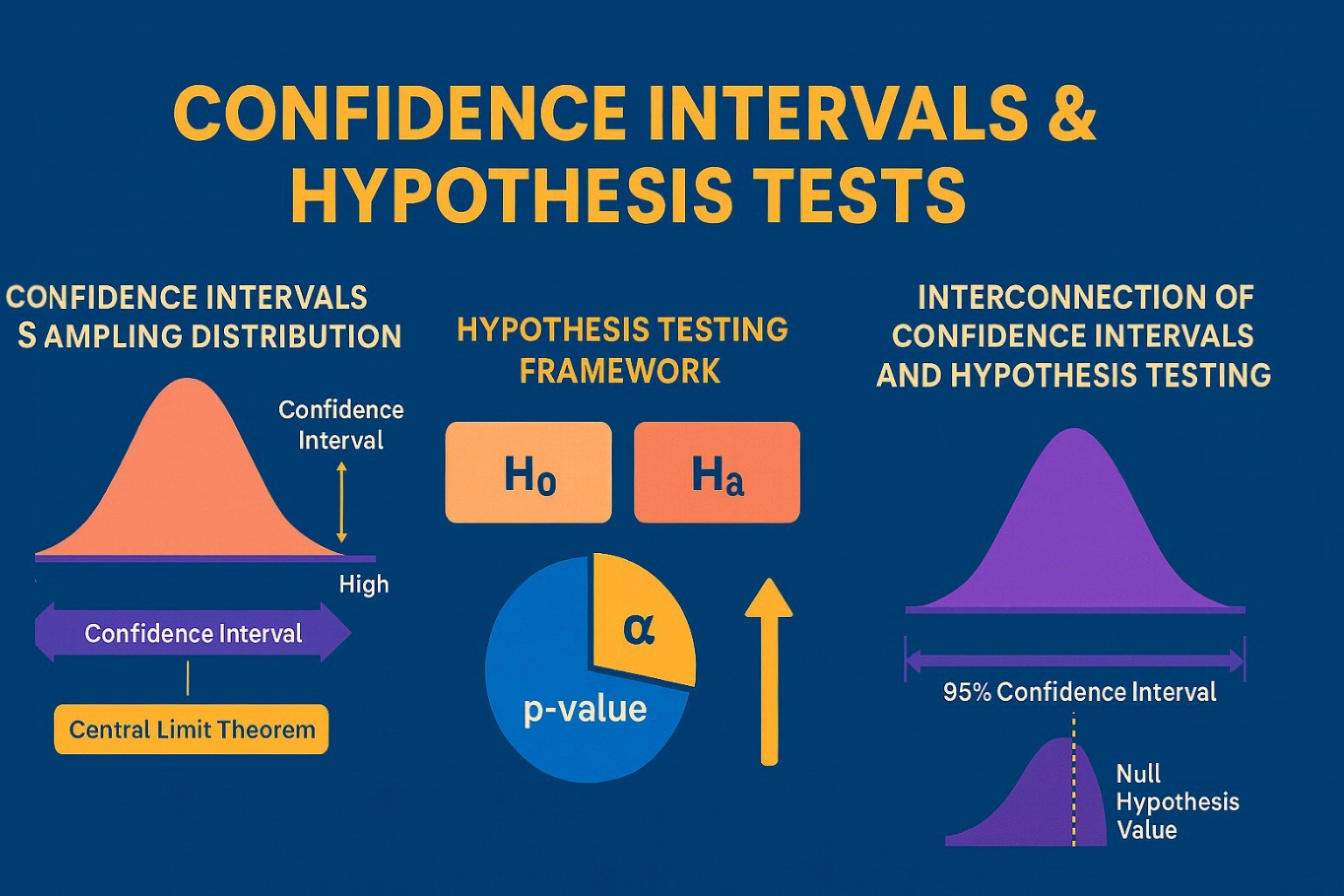PL/SQL means Procedural Language extension of SQL. It is a unique combination of SQL with procedural features of programming languages. PL/SQL was developed by the Oracle Corporation in early 1990s to improve the capabilities of SQL.
PL/SQL Block
Every PL/SQL program comprises of SQL & PL/SQL statements that form a PL/SQL block. A typical PL/SQL Block has three sections:

- Declaration section (optional)
- Execution section (mandatory)
- Exception Handling or Error section (optional)
Let us understand each section briefly:
Declaration Section – It starts with DECLARE, the reserved keyword. Well, this section is optional. It is used to declare placeholders such as constants, variables, records & cursors that are used to manipulate data in execution section. And, placeholders may probably be any of Constants, Variables, and Records that store data on a temporary basis. Cursors are declared in this section as well.
Execution Section – It starts with BEGIN, the reserved keyword & ends with END. Execution section is a mandatory section; it is the section wherein the program logic is likely to be written so as to perform any task. Programmatic constructs such as loops, conditional statement & SQL statements form an integral part of the execution section.
Exception Section – This section starts with EXCEPTION, the reserved keyword. And as mentioned above, this section is optional. This section can handle any kind of errors in the program so that finally the PL/SQL Block ends gracefully. Provided the PL/SQL Block comprises of exceptions which cannot be handled, then the Block tends to terminate unexpectedly with errors.
Each statement in the three sections should end with a semicolon. Moreover, PL/SQL blocks can probably be nested within any other PL/SQL blocks. To document code, comments can be used.
What is really great about PL/SQL?
- PL/SQL is SQL’s procedural extension; so it is very simple to write procedural code which includes SQL like it were a single language. Well, a majority of other programming languages need mapping data types, making statements & processing result sets – certain things that demand the knowledge of specific APIs.
- Data types in PL/SQL seem to be a super-set of data types in the database; hence, you rarely are required to do data type conversions while using PL/SQL. You can ask your Java or .NET programmer about how they normally find handling date values that come from a database. For sure, they would only look forward to the simplicity of PL/SQL.
- While coding business logic in the middle tier applications, one business transaction may often be composed of a number of interactions between the database and the application server. And, this adds a remarkable overhead linked with network traffic. In comparison, constructing all business logic as PL/SQL within the database means the client code requires just a single database call for every transaction, thereby minimizing the network overhead considerably.
- Being a multi-platform database, Oracle makes PL/SQL an incredibly portable language. In case your business logic appears to be located in the database, it is a means of protecting yourself from the operating system lock-in.
- Well, programming languages are likely to go in & out of fashion on a continual basis. In the past 35+ years, Oracle databases seem to have remained a major part of enterprise landscape. Moreover, suggesting that any language tends to be a safer bet compared to PL/SQL is somewhat naive. Having your business logic placed in the database in fact makes changing your client layer even simpler especially if you wish to follow fashion.
Learn PL/SQL
You can learn PL/SQL by resorting to the best PL/SQL tutorial available on the internet. There are lots of information and resources on the internet that can make you knowledgeable in the domain. However, if you wish to take a professional approach to learn PL/SQL, you can join a certificate course in PL/SQL offered by a reputed institute. You can find a good one on the internet as well.
Find a course provider to learn PL / SQL
Java training | J2EE training | J2EE Jboss training | Apache JMeter trainingTake the next step towards your professional goals in PL / SQL
Don't hesitate to talk with our course advisor right now
Receive a call
Contact NowMake a call
+1-732-338-7323Enroll for the next batch
pl sql complete course
- Dec 15 2025
- Online
pl sql complete course
- Dec 16 2025
- Online
pl sql complete course
- Dec 17 2025
- Online
pl sql online course
- Dec 18 2025
- Online
pl sql online course
- Dec 19 2025
- Online
Latest blogs on technology to explore

From Student to AI Pro: What Does Prompt Engineering Entail and How Do You Start?
Explore the growing field of prompt engineering, a vital skill for AI enthusiasts. Learn how to craft optimized prompts for tools like ChatGPT and Gemini, and discover the career opportunities and skills needed to succeed in this fast-evolving indust

How Security Classification Guides Strengthen Data Protection in Modern Cybersecurity
A Security Classification Guide (SCG) defines data protection standards, ensuring sensitive information is handled securely across all levels. By outlining confidentiality, access controls, and declassification procedures, SCGs strengthen cybersecuri

Artificial Intelligence – A Growing Field of Study for Modern Learners
Artificial Intelligence is becoming a top study choice due to high job demand and future scope. This blog explains key subjects, career opportunities, and a simple AI study roadmap to help beginners start learning and build a strong career in the AI

Java in 2026: Why This ‘Old’ Language Is Still Your Golden Ticket to a Tech Career (And Where to Learn It!
Think Java is old news? Think again! 90% of Fortune 500 companies (yes, including Google, Amazon, and Netflix) run on Java (Oracle, 2025). From Android apps to banking systems, Java is the backbone of tech—and Sulekha IT Services is your fast track t

From Student to AI Pro: What Does Prompt Engineering Entail and How Do You Start?
Learn what prompt engineering is, why it matters, and how students and professionals can start mastering AI tools like ChatGPT, Gemini, and Copilot.

Cyber Security in 2025: The Golden Ticket to a Future-Proof Career
Cyber security jobs are growing 35% faster than any other tech field (U.S. Bureau of Labor Statistics, 2024)—and the average salary is $100,000+ per year! In a world where data breaches cost businesses $4.45 million on average (IBM, 2024), cyber secu

SAP SD in 2025: Your Ticket to a High-Flying IT Career
In the fast-paced world of IT and enterprise software, SAP SD (Sales and Distribution) is the secret sauce that keeps businesses running smoothly. Whether it’s managing customer orders, pricing, shipping, or billing, SAP SD is the backbone of sales o

SAP FICO in 2025: Salary, Jobs & How to Get Certified
AP FICO professionals earn $90,000–$130,000/year in the USA and Canada—and demand is skyrocketing! If you’re eyeing a future-proof IT career, SAP FICO (Financial Accounting & Controlling) is your golden ticket. But where do you start? Sulekha IT Serv

Train Like an AI Engineer: The Smartest Career Move You’ll Make This Year!
Why AI Engineering Is the Hottest Skillset Right Now From self-driving cars to chatbots that sound eerily human, Artificial Intelligence is no longer science fiction — it’s the backbone of modern tech. And guess what? Companies across the USA and Can

Confidence Intervals & Hypothesis Tests: The Data Science Path to Generalization
Learn how confidence intervals and hypothesis tests turn sample data into reliable population insights in data science. Understand CLT, p-values, and significance to generalize results, quantify uncertainty, and make evidence-based decisions.